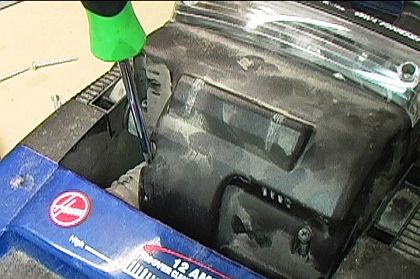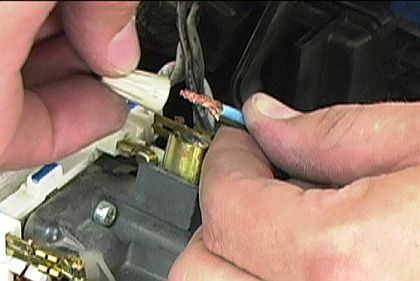Introduction: How to Replace a Vacuum Power Cord
Vacuum power cords can start to look like ominous fire hazards over time or a few accidental passes of the brush roller, and many vacuum owners may have asked themselves, "How do I replace a vacuum power cord?!"
Fixing a broken or damaged vacuum power cord is another common vacuum repair that do-it-yourself-ers can easily handle at home.
Home repairs on vacuums, tools, outdoor equipment, and other appliances can save you a truckload of money at the repair shop, and anyone can take on simple repairs like this one.
We explain the general steps for how to replace a vacuum power cord below. Wire connection styles and disassembly steps may vary from vacuum model to vacuum model, but the basic procedure remains the same for all types of vacuums.
The disassembly involved in this repair may take a little time, but getting it done at a fraction of the cost is well-worth the investment.
Depending on the vacuum model, this repair can take between 10 and 30 minutes to complete.
Remove the Old Vacuum Power Cord
Power cord replacement is a basic repair for all sorts of machines and tools, and removing the old cord is always the first step.
We use the The Hoover U5458-900 WindTunnel Supreme as our demonstration model in this repair. We offer both general repair steps and steps specific to the demonstration model.
Step 1: Access the Motor Wires on the Vacuum
Power cord wires attach to the vacuum's motor in the interior of the machine.
Because the wires must be unattached from the motor in order for the cord to come out, accessing the vacuum's motor is the first step toward cord removal.
Accessing a vacuum motor always involves some disassembly. How much disassembly will be determined by the vacuum design being repaired.
Inspect your vacuum's power cord fasteners, housings, and other fasteners to determine what will have to come off to access the motor.
For vacuums that use agitator brush systems, the cleaner's brush roller and belt must always be removed in order to free up the motor.
On the Hoover U5458-900 WindTunnel:
- Remove the bottom plate. Four screws hold it into position.

- Pull the brushroll and agitator belt out of the vacuum.

- The filter housing must be removed on this model because it gets in the way of the motor housing. Unscrew the two filter housing screws and pull the housing off of the vacuum.

- Lay the vacuum down and remove all the fasteners holding the motor housing.

- Finally, there are two boots on the U5458-900 that hold the handle portion of the cleaner to the motor portion. Unscrew the two fasteners on each boot to remove them.

- After completing the disassembly steps above, the motor housing will be free from the vacuum. Remember that the housing will still be connected to the motor by some of the wires, so be careful not to just yank the housing off the motor.
Instead, gently pull the housing up and roll it to one side in order to expose the power cord wires underneath.
Step 2: Remove the Old Power Cord Wires From the Motor
To ensure an accurate installation of the new cord, it may be a good idea to draw a simple diagram of the wire arrangement.
Also, power cord wires can be manufactured in a variety of styles. Take note of the wire styles used on your vacuum cord and double check that the new cord has the same connections.
For more information about power cord types and wire styles, please visit our Power Cord Buying Guide article.
On the Hoover U5458-900 WindTunnel:
- Our example vacuum has one black wire and one white wire coming from the power cord. The black wire is an exposed wire style that twists onto an adjacent blue motor wire. The two wires are held together with a twist-on wire cap.
Unscrew the wire cap that holds the wires together and separate them from one another.

- The white wire coming from the power cord is a terminal style wire that attaches to a fitting on the motor. Remove the white wire by pulling its terminal from the motor fitting. This can be done by hand or with a pair of needle nose pliers.
Step 3: Remove the Old Power Cord From the Vacuum
Most vacuum cords are also held onto the vacuum housing by one or more retaining pieces.
In order to finish removing the old cord, disassemble any remaining cord retainers. Take extra care to remember their orientation--both on the cord itself and on the vacuum.
These pieces usually must be transferred from the old cord to the new cord in the next step of the repair.
With the retaining pieces removed and the motor connections severed, the old power cord can now be pulled away from the vacuum cleaner.
On the Hoover U5458-900 WindTunnel:
- The U5458-900 has a cord retainer and a strain relief that must come off with the old cord.
Unscrew the cord retainer and use a pair of needle nose pliers to remove the strain relief. The strain relief helps to put the final bend in the vacuum cord, so take note of its orientation before removing it.
- After removing the retaining pieces, pull the old cord out of the vacuum.
Step 4: Dress the New Vacuum Power Cord
4. Transfer cord retaining pieces from the old cord to the new cord.
This is where taking extra care in the previous step pays off. Transfer all retaining pieces and other power cord pieces from the old cord to the new cord.
On the Hoover U5458-900 WindTunnel:
- The strain relief and cord retainer removed in the last step must be transferred from the old cord to the new cord.
Hold the two cords together to estimate the same relative positions where the retaining pieces should be installed on the new cord.
Install the New Vacuum Power Cord
The rest of this repair is a cakewalk if you took care inspect the motor wire orientation and/or draw a wire diagram.
Generally speaking, installing the new power cord on your vacuum is just matter of reproducing the orientation of its wires and retainers from before you removed the old cord.
5. Install the new power cord's motor wires.
Again, aim to reproduce the situation of all parts from before the repair started.
Small wire ties and other disposable joining pieces are sometimes removed during the old cord removal. If this is the case for your repair, use a little bit of electrical tape to join wires together and tidy up the vacuum motor area.
On the Hoover U5458-900 WindTunnel:
- Twist the black wire from the new cord onto the same blue motor wire from before.

- Secure the two wires by reusing the old wire cap.

- Install the white wire from the new cord by pressing its terminal on the motor fitting. Starting the connection by hand and then following up with a pair of pliers is usually the easiest way to do this.
Step 5: Secure the Power Cord Retaining Pieces Into Their Positions
On the Hoover U5458-900 WindTunnel:
- Return the strain relief and cord retainer to their positions. Use the strain relief to put the final bend in the cord. Install the relief with a pair of pliers.
Step 6: Re-assemble the Vacuum Cleaner
Even if a lot of disassembly was involved in your repair, this is still the home stretch . Figuring out what to disassemble in the beginning of the repair is usually the most time-consuming part, as opposed to the disassembly itself.
Return all fasteners, housings, and other pieces of the vacuum to their correct positions now that the new cord is installed. Reassemble the vacuum in reverse order.
On the Hoover U5458-900 WindTunnel:
- Replace the motor housing and its fasteners. Be careful not to pinch any wires between the housing covers.
- Replace the boots holding the top and bottom vacuum portions together.
- Replace the filter housing and its screws.
- Reinstall the vacuum belt and brush roller.
- Return the bottom plate and its four screws to their positions.
Conclusion
Enter your vacuum's model number in the search field at the top of this page to get started with your power cord replacement!
eReplacementParts.com carries a full line of O.E.M. Vacuum Parts backed up by our streamlined ordering system and dedicated customer service.
Browse our inventory for Hoover vacuum parts, Eureka vacuum parts, Dirt Devil vacuum parts, and more.
Thank you for reading about how to replace a vacuum power cord. eReplacementParts.com is here to provide all the parts that make any repair an easy fix, including that last part, the know-how.













